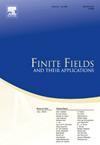On the functions which are CCZ-equivalent but not EA-equivalent to quadratic functions over Fpn
IF 1.2
3区 数学
Q1 MATHEMATICS
引用次数: 0
Abstract
For a given function F from to itself, determining whether there exists a function which is CCZ-equivalent but EA-inequivalent to F is a very important and interesting problem. For example, Kölsch [33] showed that there is no function which is CCZ-equivalent but EA-inequivalent to the inverse function. On the other hand, for the cases of Gold function and over , Budaghyan, Carlet and Pott (respectively, Budaghyan, Carlet and Leander) [12], [14] found functions which are CCZ-equivalent but EA-inequivalent to F. In this paper, when a given function F has a component function which has a linear structure, we present functions which are CCZ-equivalent to F, and if suitable conditions are satisfied, the constructed functions are shown to be EA-inequivalent to F. As a consequence, for every quadratic function F on () with nonlinearity greater than 0 and differential uniformity not exceeding , we explicitly construct functions which are CCZ-equivalent but EA-inequivalent to F. Also for every non-planar quadratic function on with and differential uniformity not exceeding , we explicitly construct functions which are CCZ-equivalent but EA-inequivalent to F. As an application, for a proper divisor m of n, we present many examples of -functions F on such that the CCZ-equivalence class of F is strictly larger than the EA-equivalence class of F.
对于Fpn上的二次函数,ccz等价但ea不等价的函数
对于给定函数F从Fpn到自身,确定是否存在与F等价ccz但ea不等价的函数是一个非常重要和有趣的问题。例如,Kölsch[33]表明,不存在与逆函数等价的函数,而不存在与逆函数等价的函数。另一方面,对于Gold函数F(x)=x2i+1和F(x)=x3+Tr(x9) / F2n的情况,Budaghyan, Carlet和Pott(分别为Budaghyan, Carlet和Leander)[12],[14]发现了ccz等价但ea不等价于F的函数。在本文中,当给定函数F具有线性结构的分量函数时,我们给出了ccz等价于F的函数,如果满足合适的条件,因此,对于F2n (n≥4)上每一个非线性大于0且微分均匀性不超过2n−3的二次函数F,我们显式地构造出ccz等效但ea不等于F的函数。对于Fpn (p>2,n≥4)上每一个|WF|≤pn−1且微分均匀性不超过pn−3的非平面二次函数,作为一个应用,对于n的真因子m,我们给出了Fpn上的(n,m)函数F的许多例子,使得F的ccz等价类严格大于F的ea等价类。
本文章由计算机程序翻译,如有差异,请以英文原文为准。
求助全文
约1分钟内获得全文
求助全文
来源期刊
CiteScore
2.00
自引率
20.00%
发文量
133
审稿时长
6-12 weeks
期刊介绍:
Finite Fields and Their Applications is a peer-reviewed technical journal publishing papers in finite field theory as well as in applications of finite fields. As a result of applications in a wide variety of areas, finite fields are increasingly important in several areas of mathematics, including linear and abstract algebra, number theory and algebraic geometry, as well as in computer science, statistics, information theory, and engineering.
For cohesion, and because so many applications rely on various theoretical properties of finite fields, it is essential that there be a core of high-quality papers on theoretical aspects. In addition, since much of the vitality of the area comes from computational problems, the journal publishes papers on computational aspects of finite fields as well as on algorithms and complexity of finite field-related methods.
The journal also publishes papers in various applications including, but not limited to, algebraic coding theory, cryptology, combinatorial design theory, pseudorandom number generation, and linear recurring sequences. There are other areas of application to be included, but the important point is that finite fields play a nontrivial role in the theory, application, or algorithm.

 求助内容:
求助内容: 应助结果提醒方式:
应助结果提醒方式:


